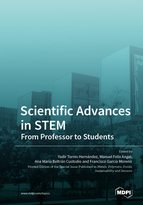Topic Menu
► Topic MenuTopic Editors




Scientific Advances in STEM: From Professor to Students

A printed edition is available here.
Topic Information
Dear Colleagues,
The aim of this article collection is to contribute to the advancement of the Science and Engineering fields and their impact on the industrial sector, which requires a multidisciplinary approach.
The University generates and transmits knowledge to serve society. Social demands continuously evolve, mainly as a consequence of cultural, scientific, and technological development. Researchers must contextualize the subjects they investigate to their application to the local industry and community organizations, frequently using a multidisciplinary point of view, to enhance the progress in a wide variety of fields (aeronautics, automotive, biomedical, electrical and renewable energy, communications, environmental, electronic components, etc.).
Most investigations in the fields of science and engineering require the work of multidisciplinary teams, representing a stockpile of research projects in different stages (final year projects, master’s or doctoral studies). In this context, this Topic offers a framework for integrating interdisciplinary research, drawing together experimental and theoretical contributions in a wide variety of fields. Topics of interest could include, but are not limited to:
General topics:
- Science and technology of materials;
- Physics and applied mathematics;
- Industrial and environmental chemistry;
- Analytic chemistry;
- Intelligent systems and electronic technology;
- Product design, development, and engineering;
- Computerized, robotic, and neuromorphic industrial systems;
- Computer architecture and technology.
Particular Themes:
- Coatings and nanostructured materials for solar energy applications (in particular for high-temperature concentrated solar power applications);
- Development of functional materials for additive manufacturing (i.e., applications in biomedicine);
- Advanced optical characterization or nano- and microstructures and thin films;
- Biopolymer-based superabsorbent materials from agro-food bioresidues;
- Biodegradable protein‐based polymer materials for the controlled release of micronutrients in horticulture;
- Interfacial rheology and its applications to protein-based emulsion processing and stability;
- Deep-learning systems for diagnosis, prevention, and pattern recognition;
- Bio-inspired systems for sensory fusion and control;
- Current advances in computer architecture;
- Artificial intelligence in smart cities applications;
- Energy forecasting and flexibility services;
- Advances in food and by-products development and characterization;
- New trends in sustainable cities and industries;
- Intelligent and sustainable optimization of industrial engineering projects;
- Multifunctional and smart toys for children with autism spectrum disorder;
- Weighting with life-cycle assessment and cradle-to-cradle (methodology for global sustainability design social and socio-economic life cycle assessment: towards quantitative methods in small and medium-sized enterprises);
- Work of separation in metal–metal interfaces;
- Emerging pollutants in the urban water cycle;
- Analysis of emerging pollutants in environmental samples;
- Design, manufacture, and characterization of WC-Co/WC-Co laminates;
- Wear and scratch resistance of porous materials for biomedical applications;
- Biomechanical and biofunctional behavior of porous titanium parts coated with hydroxyapatite using the sol–gel technique;
- Bioactive glass bilayer coatings on porous titanium samples.
Prof. Dr. Yadir Torres Hernández
Dr. Manuel Félix Ángel
Dr. Ana María Beltrán Custodio
Prof. Dr. Francisco Garcia Moreno
Keywords
- solar energy applications
- additive manufacturing
- coatings
- functional materials
- tribological and mechanical behavior
- bio residues, biopolymer
- computer architecture
- artificial intelligence
- smart cities
- energy forecasting
- food
- sustainable cities and industries
- life cycle assessment
- emerging pollutants
- porous materials
- cellular and bacterial behavior
- powder technology
Participating Journals
| Journal Name | Impact Factor | CiteScore | Launched Year | First Decision (median) | APC |
|---|---|---|---|---|---|

Metals
|
2.9 | 4.4 | 2011 | 15 Days | CHF 2600 |

Polymers
|
5.0 | 6.6 | 2009 | 13.7 Days | CHF 2700 |

Foods
|
5.2 | 5.8 | 2012 | 13.1 Days | CHF 2900 |

Sustainability
|
3.9 | 5.8 | 2009 | 18.8 Days | CHF 2400 |

Sensors
|
3.9 | 6.8 | 2001 | 17 Days | CHF 2600 |

MDPI Topics is cooperating with Preprints.org and has built a direct connection between MDPI journals and Preprints.org. Authors are encouraged to enjoy the benefits by posting a preprint at Preprints.org prior to publication:
- Immediately share your ideas ahead of publication and establish your research priority;
- Protect your idea from being stolen with this time-stamped preprint article;
- Enhance the exposure and impact of your research;
- Receive feedback from your peers in advance;
- Have it indexed in Web of Science (Preprint Citation Index), Google Scholar, Crossref, SHARE, PrePubMed, Scilit and Europe PMC.

